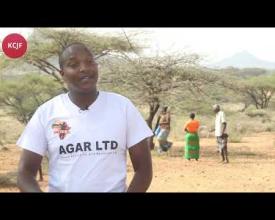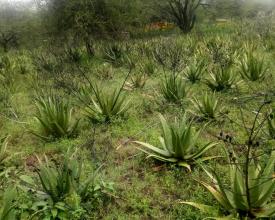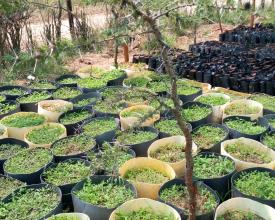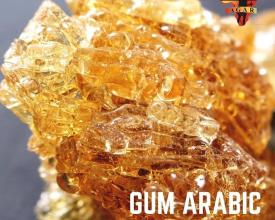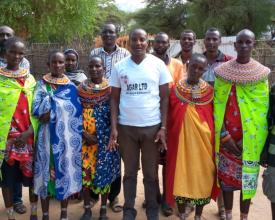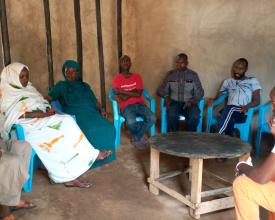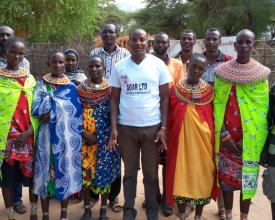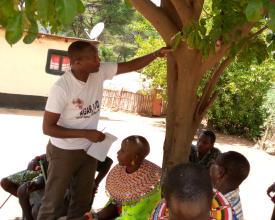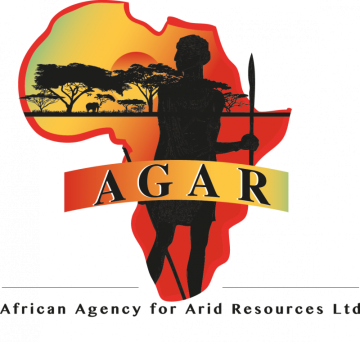
Kenya Arid Lands Value Chain Development Initiative (KAVADI) ©
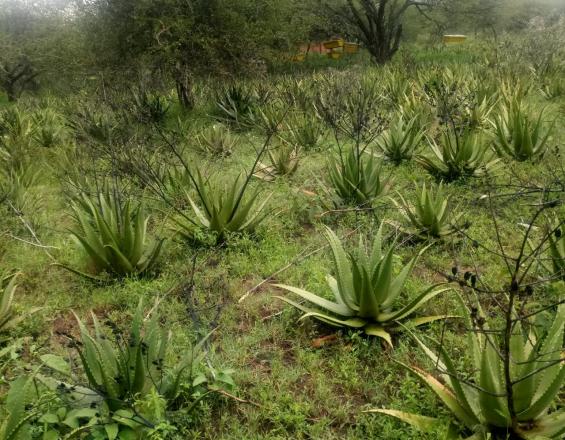
"ASAL – Arid and Semi-Arid Lands", covers around the 80 % of the national territory of Kenya. The inhabitants of these counties are mainly pastoral communities covering vast areas. Yet, Kenya’s Arid and Semi-arid lands are endowed with a rich diversity of plant resources exuding gum and resins.
The KAVADI approach builds capacity in arid lands by training communities in wild harvesting techniques of gum Arabic and other resins such as Frankincense and Myrrh, and through the farming of Aloe plots and the pilot plantations of trees with commercial interests. These drought resistant resources create alternative livelihoods opportunities, making communities more resilient and in a better position to mitigate vulnerability to drought. On top of livelihood building, the plantations of drought resistant trees and plants regenerate and restore landscapes, since these species do well in terrains considered "degraded" hence not used for either traditional agriculture or pasture.
Context
Challenges addressed
- De-forestation
- Climate change (desertification, soil erosion)
- Informality of Non Timber Forest Products (NTFP) sectors
- Scarcity of investment in the sector
Location
Process
Summary of the process
AGAR's is keen to contribute to the improvement of living conditions of the rural communities in arid and semi-arid lands, promoting inclusive and sustainable socio-economic development through the enhancement of high potential agroforestry resources, in synergy with the local private sector and national agenda.
For this concept to work effectively our biding blocks rely on each other for a succesful impact, they do this by:
- Relying on good partnerships from all the sector players in their respective roles to increase the productive potential of gum, resins and aloe through the synergistic action of the public and private sector
- Sustainable management of natural resources through the introduction of correct environmental practices , enhancing the adaptation strategies to climate change, reducing the impact of desertification and deforestation and promoting women's social inclusion in production processes .
- Trainings on business management, accountability and sales are performed targeting the communities economical resilience.
- Formalization of sectorial capacity, increased organizational and financial management and set-up of policies and standards.
Building Blocks
Partnerships, Synergies and Collaborations
The company has created partnership with players in the gum and resins sector and in the aloe and cosmetics industry for a collaborative market engagement. Partnership with the Laikipia permaculture has resulted to creation of the aloe nursery and improving the products that the groups in Laikipia were formulating, certifying the organic and registering the products with the Ethical Bio Trade. This means that the products will gain the global demand as they are traceable and quality assured.
Currently, we collaborate closely with the County Government of Isiolo, the County Government of Turkana, the County Government of Marsabit and the County Government of Wajir in Kenya. We also collaborate often with institutions such as Kenya Forestry Association (KFS), Kenya Forestry Research Institute (KEFRI), the Gum And Resins Association (GARA) where we are executive committee member ensuring quality standards, National Environment Management Authority (NEMA) and Kenya Wildlife Service (KWS). Over the years we partnered up with NGOs among which CEFA, COOPI, CESVI, World Vision, VSF-G in Kenya, C&D – Africa Mission in Uganda, and from 2019 FAO and WFP among UN agencies.
Enabling factors
- Good working relationship with the locals.
- Existing work relationships with ready market players
- Facilitation of education on gums and resins aloe value chain additions
- Provision of harvesting and grading tools for the raw materials.
- Diversified sources of income.
Lesson learned
- Power of collaboration - with good working relationships with the locals and county government respectively has enabled us iin partnerships with locals allocation of 100 acres of community land for restoration through aloe plantations and Gums and resins tree species plantantions.
- Because of the capacity building investment that AGAR has put in with our collecting partners and aloe farmes, there has been a big improvement in quantity and quality of the sourced raw materials, showing with good information and improved harvesting techniques the farmers and collectors can do a great job.
- With multiple sources of incoe a household in Kenyan arid areas can be able to adapt to the changes that come with climate change in the events of long droughts and other natural calamities, they can be able to cushion themselves from their hazards through diversified sources of income from harvesting and colectio of aloe and gums and resins.
- With good partners on board from both public and the private sector, there is room for better policies and guidelines to govern this sector of Non Timber Forest Product.
Bio-Diversity, Conservation and Sustainability
Planting of enhanced high potential trees of commercial interest such as Acacia Senegal for gum Arabic, Boswelia Neglecta for Frankincense, and indigenous aloe species (Turkanensis, Secundiflora) in the Kenyan Arid lands has helped with the improved management of natural resources by the community woodlands forest association members, which we helped to form, who act as the custodians of the environment, who are also trained on correct environmental management practices.
The recovery of local biodiversity and use of innovative agroecological techniques by the local communities in the arid areas enhances their adaptation strategies to climate change thereby reducing the impact of desertification which is brought about by widespread deforestation for coal burning as a diverse source of income apart from pastoralism which is the main source of income for people in the arid regions has left the communities be aid reliant in times of droughts.
Through our capacity buildings, the communities have been able to improve their skills on sustainable management of natural resources through the introduction of correct environmental practices, enhancing the adaptation strategies to climate change, reducing the impact of desertification and deforestation.
Enabling factors
- Availability of large parcels of land for restoration
- Availability of plant species that can survive in arid areas and used for income generation.
- Availability of techiniques and specialists who train how to restore their land.
- Embracement of learning and collaboration from the locals.
- Capacity building on correct way of farming, harvesting and collection of aloe and gums and resins raw materials.
- Collaboration by our partners like county governments for allocating idle community land for ecological conservation.
Lesson learned
- Plant species endemic in arid areas can be used to conserve and restore the ecosystem.
- Community members can ptotect their own ecosysytems with both indigenous and scientific methods of conservation.
- Collaborattion between private and government actors can bring positive results in ecologial conservation.
- Farming of indigenous species and tending to them can bring a diversified source of income.
- Arid areas are rich in natural resources if they are well maintained can be used for income generation.
Capacity and Resilience Building
AGAR's main objective in capacity building, is to contribute to the improvement of living conditions of the rural communities in arid and semi-arid lands by promoting inclusive and sustainable socio-economic development through the enhancement of high potential agroforestry resources, in synergy with the local private sector and national agenda. We do this through trainings and seminars on environmentally sustainable agro-forestry value chains which community members are taken through:
- Sustainable management of natural resources
- Propagation, transplanting, harvesting and formulation of aloe and its products
- Harvesting, sorting and grading of gums and resins
- Provision of gum and resins haversting and grading tools
- Provision of storage for gums and resins
- Business principles and development
With these trainings the communities:
- Build economic resilience because of alternative source of income
- Build strong independent communities through provision of work opportunities,
- Enhance the adaptation strategies to climate change,
- Reducing the impact of desertification and deforestation and
- Promotes women's, youth and people living with disabilities social inclusion in production processes
Enabling factors
- Availability of training knowledge and resources
- Availability of existing farmers and collector who can be trained on vaue addition.
- Availability of a ready market that demands quality products hence the training for quality raw materials.
- Availability of ready man power
- Availability of natural resources i.e land
- Readyness to learn from the community
- Embracement of the project by the communities, local governments and business partners.
Lesson learned
- Healthy partnerships with local communities can result to remarkable environmental and economical progess.
- With all actors in a sector working together, big strides are made in the development of the gums and resins sector opening ways for better policies and regulations ensuring the quality management of non forest timber products.
- For end good product, the plants and trees have to be taken good care of, so as to improve on the quality of the end product hence the big investment on capacity building .
- New techniques have to be incorporated in farming and harvesting for quality end products
Impacts
- Income generation activities from alternative and environmentally
sustainable agro-forestry value chains - Access to markets for emerging sectors through strengthening the links with public and private actors, in order to build strategic alliances for product promotion and commercialization;
- 100 to 200 acres of degraded lands is restored through the use of drought resistant trees and plants (aloe, acacia and boswellia species)
Beneficiaries
The KAVADI concept has been designed to make sure the most vulnerable communities in the region, such as:
- Pastoralists
- Women
- Youth
- Persons with disabilities
Sustainable Development Goals
Story
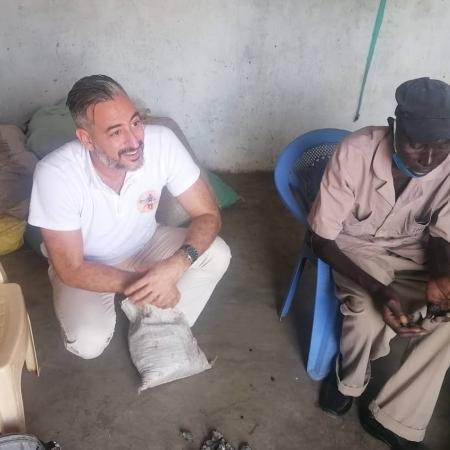
Before founding Agar Limited, I (Tommaso Menini - Director) worked for several years in arid lands as a business development specialist with several NGOs: during this time, I have seen endless initiatives aiming at strengthening micro-economies through income generation activities. What all these initiatives lacked, including the EU Funded project I personally led in Isiolo for 2.5 years, was private sector's engagement from the design stage. In most projects the private sector was only involved at the very end while looking for an exit strategy. We believe that truly sustainable development can only be achieved by identifying market opportunities and helping marginalized groups to develop skills and capacities in order to develop partnerships with dynamic businesses on equitable terms.
I designed KAVADI © with in mind the base of the pyramid in our trade, the communities in arid lands, which would benefit from a structure that no development initiative has yet managed to build. With this in mind, I re-joined the private sector in 2017 after nearly 10 years working in the aid sector re-activating a company dealing with natural resources in North East Kenya, advocating for adequate environmental practices and the socio-economic empowerment of pastoralist communities through income diversification and as of late, the use of drought resistant plants and trees as a mean to restore degraded lands.
I founded "African Agency for Arid Resources Ltd”, a company specialized in dry land tree species, social economic empowerment in arid lands, natural resources development and environmental conservation in 2018 and in 2019 I became a UN consultant for a project working in 4 ASAL counties in Kenya on land restoration and bio-enterpises developent, which I am currently contributing to.
